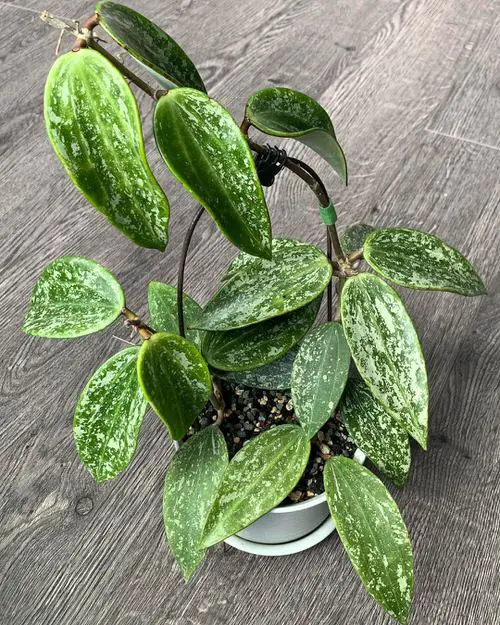Learn everything about Hoya Rangsan Care & Growing Information in this detailed article and bring home a beautiful specimen with exotic flora!

Are you looking for beautiful foliage plants to add to your collection? Here’s an exclusive article on Hoya Rangsan Care & Growing Information, you must check out!
Here are the top secrets to making Hoyas bloom
Hoya Rangsan Plant Profile
Native to Southeast Asia and Australia, Hoya Rangsan is an epiphytic flowering plant featuring narrow and ovate waxy green foliage with greenish-yellow splotches. The lush leaves fade to pale yellow as the plant reaches maturity.
It blooms star-shaped flowers in pale yellow with a pink undertone. It is a low-maintainance plant that thrives in the cracks and crevices of rocks and trees in its native land.
Botanical Name: Hoya sp. Rangsan
Learn all about growing Hoya Crimson Queen here
Propagating Hoya Rangsan

Propagating Hoya Rangsan is an easy task and can be done via stem cutting or direct sowing of seeds. While the former clones the parent plant, the latter produces new offspring with different characteristics.
From Seeds:
- Buy good-quality seeds from a local nursery or an online store.
- Soak 4-6 seeds overnight to boost the chances of propagation.
- Sprinkle the seeds 1 inch deep into the growing medium.
- Water well and provide ample indirect sunlight.
- The seeds will sprout in 10-15 days.
From Cuttings:
- Get a healthy plant and snip out a 5-6 inches stem from above the leaf node.
- Remove the lower leaves, keeping the upper ones intact.
- You may dip the cut end in the rooting hormone to boost the chances of successful propagation. However, this step is entirely optional.
- Plant it directly into a well-draining growing medium.
- Water well and ensure it gets ample bright but indirect light.
Requirements for Growing Hoya Rangsan

Sunlight
The plant appreciates bright but indirect sunlight. Keep it away from direct sun as that will burn its foliage. However, 2-3 hours of mild morning sunlight would enhance the foliage color and flower production.
Watering
Water the plant once every week during spring and summer. Hoyas love a well-draining medium, so it is essential to let the topsoil dry a little between the watering sessions. Do not let the soil dry out completely.
Soil
The epiphyte needs a well-draining potting mix to thrive well. Combine two parts of garden soil, one part perlite, and one part of coarse coconut coir for the perfect blend.
Temperature & Humidity
Hoyas prefer a temperature range of 60F to 85F or 16C to 29C. Do not expose the plants to a higher temperature as the foliage color will fade, affecting its growth. Also, it is essential to shield the flowers against extreme temperature changes for a lasting blooming period.
The plant needs high humidity of about 40-60%. Keep a humidifier handy to cover up for the dry days. You may also use a pebble tray.
Have a look at the best types of Hoyas here
Hoya Rangsan Care

Fertilizer
Hoya Rangsan is not a heavy feeder, but it would appreciate a monthly dose of diluted liquid fertilizer (1/2 of its strength) during spring and summer. However, you’ll need to cut down on feeding your plant in the colder months.
You may also use a high phosphate plant food before the blooming season to boost flower production.
Pests & Diseases
Hoyas are susceptible to sap-sucking pests, including aphids, mealybugs, and spider mites. Spray the plant with insecticidal neem oil solution to fight them.
Avoid overwatering to save it from potential fungal diseases.


